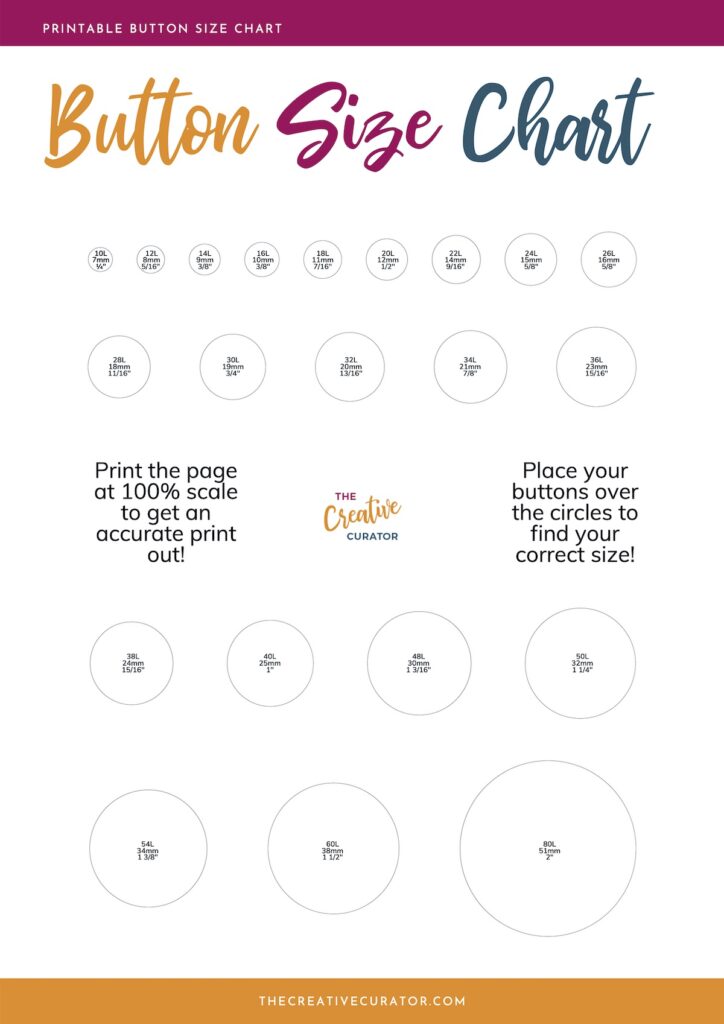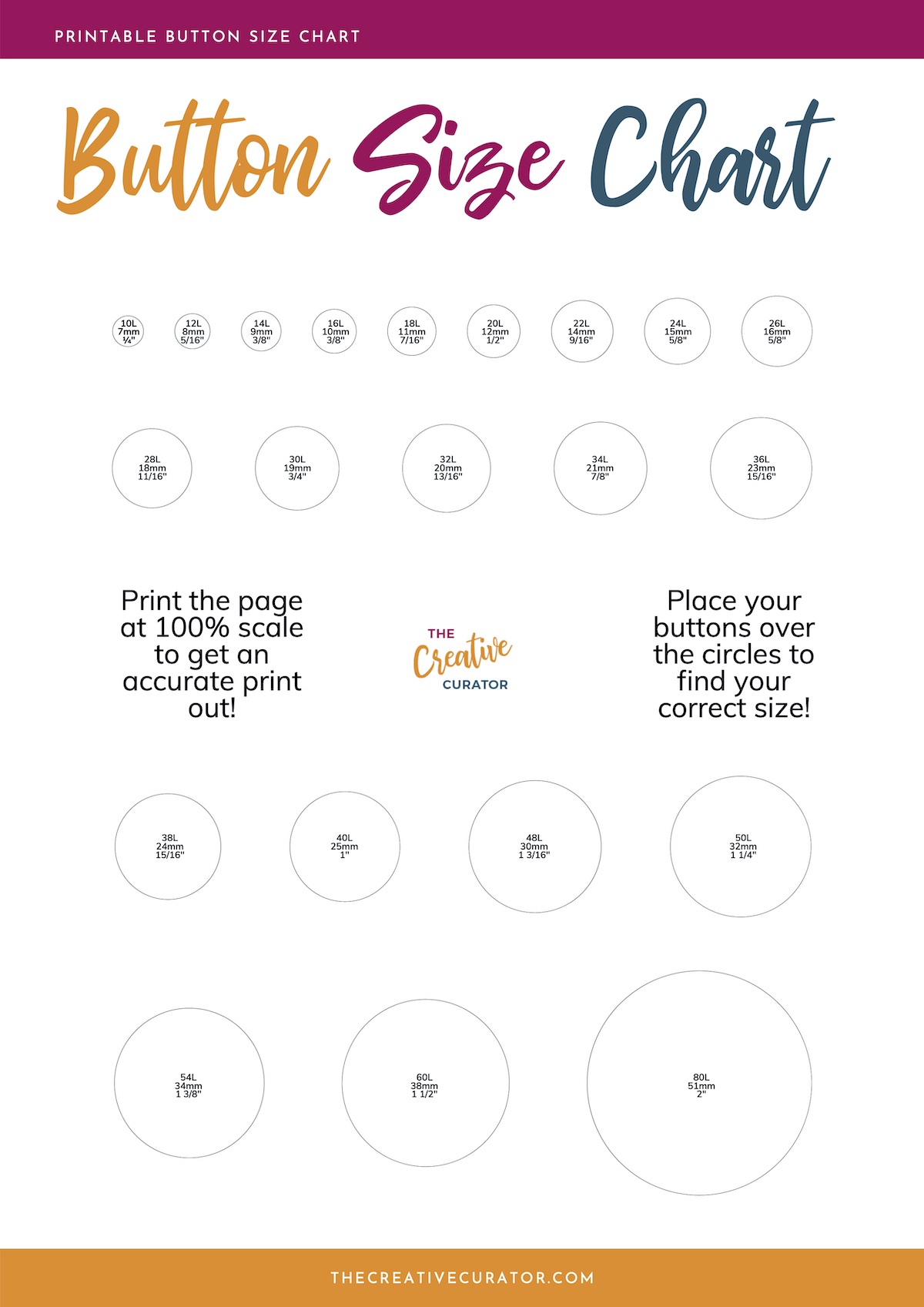Printable Button Size Chart: How To Measure Buttons
Here’s a printable button size chart and guide on how to measure buttons for yourself.
Buttons are one of the most common clothes fastenings used for garment closures, from a simple button-fly on pants to the more elaborate and oversized buttons found on haute couture garments.
But how do you actually measure buttons or know which size button you need for a project?
Ligne: The Standard Button Measurement
Let me start with explaining the traditional measurement used for button sizes.
- Buttons are actually measured and assigned the letter L – which stands for ‘Ligne’!
- Each ‘L’ is 0.025″ (0.635mm), and is the measurement across the centre of the button, the diameter.
The term ‘ligne’ came about in the 18th century thanks to the use by German button makers!
Wikipedia
How Do You Know The Size Of Buttons?
Back in the day, I vaguely recall seeing a button with a small number marked on the wrong side – a measurement!
Sadly, there’s no way to know the size of buttons nowadays without measuring them or using a button size chart!
How To Measure A Button

To work out the size of a button without the use of a button chart, you’ll want a measuring tool called a ‘seam gauge’.
Yes, you could use a tape measure (inaccurate) or a ruler (tricky) but in my many years of experience, measuring buttons with a seam gauge is a far easier task.
Here’s how:
- Find the button you want to measure the size of
- Determine which type of button it is:
- If it’s a shank button, place the shank in the gap in the centre of the seam gauge, pop a finger at the top to hold the button in long with the edge and then ease the knob to the other side of the button
- If it’s a flat button, hold the seam gauge so that you have one thumb at the shorter edge of it, pop the button onto the metal measuring section, and butt it up against your thumb / gauge edge and then ease the measuring knob to the opposite edge of your button.
- Once the knob is in place you can remove your thumb and the button and make note of the button size!
If you’re trying to measure the button in order to sew a buttonhole, you may want to check out this guide to eight types of buttonholes first!
What Are Normal Button Dimensions

To be honest, there are no normal button dimensions because there are so many different types of buttons and it depends on what you plan to use the button for!
The most common button is the standard shirt button – 16L / 10mm / 3/8” – perhaps because shirts are such a popular and common garment type.
Note that buttons usually sit inline with the centre line unless double breasted garments:
- Centre front on shorts, trousers, skirts, shirts, tops and coats / jackets
- Middle of the waistband if one button or evenly spaced if multiple
- Centre back on skirts, tops, dresses
- And of course the ‘centre’ can be the side seam, being in between the front and back of the garment
Button Sizes For Different Garment Types
As stated earlier, buttons come in different sizes, from teeny tiny small buttons to large oversized types.
Let’s take a look at the buttons usually used in each garment type!
Shirt Buttons
Shirt button sizes differ depending on which part of a shirt it is being used on:
- Shirt cuff
- Collar
- Button stand (also known as button placket)
The Shirt Cuff Buttons Sizes

The shirt cuff can have one or buttons depending on the depth of the cuff.
Standard size for the cuff buttons is 10mm diameter and 9mm for the placket button.
The Collar Button Sizes

You’ll notice that sometimes, shirt collars in particular have smaller buttons holding the pointed part of the collar in place. These buttons are usually: 9mm diameter
The Button Stand Button Sizes

Also known as the button placket amongst home sewers the button stand is where you’ll find the majority of buttons on a shirt.
It is normal for the buttons on the stand and the one closing the collar to be the same size, and the standard size is: 10mm diameter
Trouser Fly Buttons
The trouser fly may have on button – usually around 20mm diameter – or a vertical line of buttons as the closure, with them all being the same size.
Skirt Buttons
Buttons on skirts can be found as functional buttons on the waistband at centre front, centre back and side seam or as decorative buttons on the front of the skirt.
Buttons used for suctions tend to be between 10mm and 20mm while the buttons used for decoration purposes can be greater than the 34mm size button I recently used!
Dress Buttons
Again, buttons on dresses are usually confined to centre front and centre back openings, though of course they can be used anywhere on a dress at the designers choosing.
If buttons are used, they will usually be sized no smaller than 8mm.
Blouse Buttons
I only have one blouse that I can measure the buttons of, and those buttons are 12mm!
Coat And Jacket Buttons

Checking across multiple coats and jackets of my other half, from tailored wool coats to work jackets, and the standard button size is 20mm.
This can of course be a way to make a statement by adding large oversized buttons to coats and jackets!
Jeans Buttons
The jeans buttons I have are all 17mm in diameter, and this shows accurate on the commercial jeans I have and am wearing.
Buttons As A Design Choice

Ultimately, the size of the button you choose to use on any of your sewing projects should be a design choice.
And of course, button sizing will need to change based upon the type of fabric used:
A cropped jacket in silk organza will need smaller / lighter buttons so they don’t drag and weigh down the fabric
A cropped jacket in heavy wool will need a bigger button to to stand out in the structure of the wool.
Finally, don’t forget that there needs to be space around the button:
- Waistbands should be wider than the button being used
- Button stands should have space for the buttons to sit at centre front or centre back and ‘breathe’
- Buttons on collars and lapels should have space around them too
Don’t crowd your buttons – give them space to breathe and look good!
Printable Button Size Chart
In case you have no inclination to manually measure your buttons, I created this printable button size chart for you to print at home and keep close to hand.
Click the image to be taken to the PDF version and download for free!

Make sure to print it at 100% scale so that each button size is accurate!
Finally, I wrote a more in-depth guide on the different types of buttons used in sewing!







fabulous! thank you! I’m educating myself on buttons sizes and have this question relative to the button size chart:
Button size 14L and 16L are different in mm yet both are 3/8″. Is there a fashion industry backstory to this?
HI Tara! Apologies, I’ve been away on holidays and only now getting to answering questions. The difference in mm is 1mm which as an inch would be 0.039 inches, an amount so tiny that the only people likely to need that difference added to a chart would be those creating digital patterns. For the general home sewer, it is negligible. 🙂
You write:
Each ‘L’ is 0.025mm (0.635”)
I think you have that backwards, and it should be:
Each ‘L’ is 0.025″ (0.635mm)
Other than that, great article and the best chart I’ve seen!
Gwyn, thank you! I think I had probably been writing out too many numbers and you are the first person to catch that I made a small error.